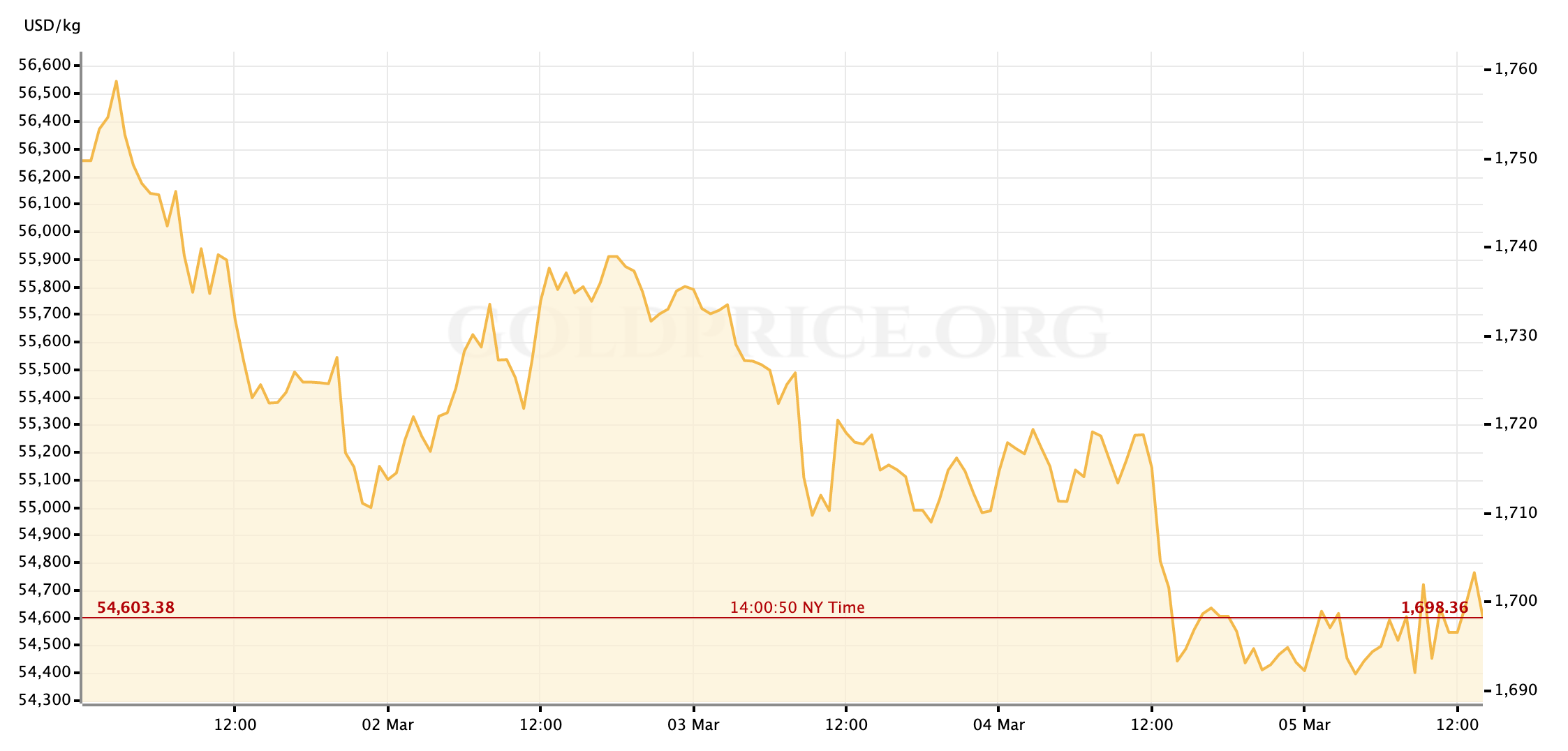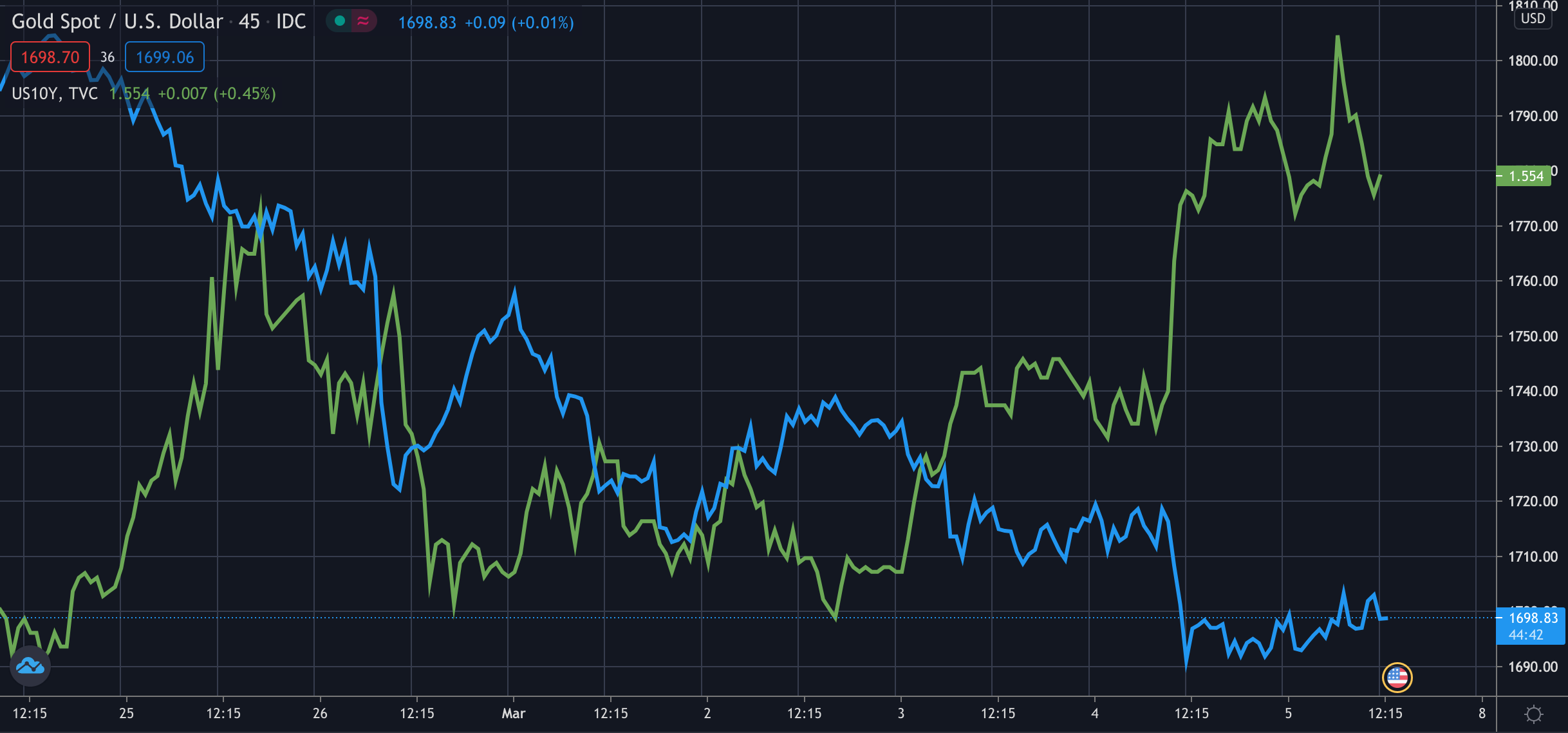Happy Friday, traders. Welcome to our weekly market wrap, where we take a look back at these last five trading days with a focus on the market news, economic data and headlines that had the most impact on gold prices—and may continue to into the future—as well as the charts for silver, the US Dollar and other key correlated assets.
Gold prices are well below the position that began the week, as the same primary pressures that came to bear on metals last week have persisted and, particularly during Thursday’s trading session, strengthened.

So, what kind of week has it been?
Like the one before, it’s a week whose story for precious metals prices can be told pretty simply: After taking a brief step back to end last week and begin this one, US Treasury yields have either remained elevated (relative to the last 12 months) or pushed higher through the last five trading sessions, driven by a consistent selling pressure in the market for government debt. At the same, the US Dollar has been gaining strength in another important reversal of recent trends. These two moves in correlated assets have combined to weigh heavily on the price of gold, as well as silver: Following the strongest moves of the week in yields and DXY on Thursday, the yellow metal finds itself at the end of the week sitting just below $1700/oz. What was previously anticipated to be a line of support may now prove to be considerable resistance to any kind of rebound in prices.
The US Bond Market Continued to Steer the Ship in Global Developed Markets this Week
The move in the US government bond market continues to be driven by two primary factors:
- Expectations for a sharp pickup in government spending, initially as a result of the $1 trillion+ COVID-19 relief package that investors expect to be passed by the end of March, but also other injections of fiscal spending in the medium-term such as a large infrastructure-spending bill (or two.)
- Optimistic projections of economic recovery and growth, as a result of said injections of fiscal stimulus coupled with the Fed’s monetary policy remaining ultra-easy.
Put in simple terms of where investment is flowing, this means that managers and investors are opting out of current US Treasury debt—which continues to offer an historically low yield across the curve—in favor of bets on US economic growth and other asset classes that should perform well in a future higher-inflation environment. (Although, as we’ll touch on briefly later, that doesn’t mean that investors are moving immediately into equity positions at the same time—some are clearly waiting in cash for the time being.
Regarding inflation expectations, I should mention that there isn’t consensus agreement about the main reasons for the continuing shift in bond markets: There are more than a few analysts and market participants suggesting that the sell-off in government debt is being led primarily by concerns about over-accelerating inflation as a result of the much larger government spending (and the pursuant debt issuance.) It’s not an argument without merit by any means, but I do feel most confident with the view that this is a move driven by optimistic growth expectations and not a future fire that will need to be quickly put out. By all accounts, Chairman Powell and other key member of the FOMC seem to hold that view as well.
Powell, Reaffirming a Hands-Off Approach for 2021, Drove the Markets Most Volatile Day
Speaking of the Chair: Certainly, the biggest move in yields this week was precipitated by an interview that Powell gave to the Wall Street Journal. In the talk, Powell maintained his (and the FOMC’s) recent party line that they will be much more willing in the past to hold rates and other monetary policy tools ultra-low and ultra-accommodative until both price inflation and labor market tightness not only “meet” the levels of the Fed’s mandate but look poised to hold consistently at or above them. Powell also repeated his view that overall inflation in the US economy will remain low, at the very least through the end of the year, and that any price acceleration measured in the meantime will be “transitory.”
What the bond market reacted too specifically, though, was comments that Powell didn’t make. That is: Powell offered no words of pushback or even concern about the recent spike in Treasury yields, siding with the view that the core of the move is based on a bullish outlook for the US markets and economic performance. With no suggestion that the Fed will step in to counter the sell-off in bonds or the rise in benchmark yields, bond market participants pushed the selling further and drove yields on the 10-year note well above 1.5% for the first time this week in the move that wouldn’t top out until Friday morning at a high of 1.6%.
Return of the Greenback
The Greenback was definitely a player in precious metals’ story last week, but took a more prominent role this week. The US Dollar, encouraged by many of the same impulses and outlooks that currently fuel bond markets, has risen back to levels we haven’t seen since the end of 2020. This is a reversal of the general trend since the start of last year which has seen a weaker Dollar providing a key tailwind to soaring stock market valuations since the onset of the COVID-19 pandemic.
And like the bond market, the biggest swing for the US Dollar against its primary trading partners came as a result of Jerome Powell’s comments on Thursday. (Although, it may be more hair-splittingly accurate to say that at least some of the Dollar’s move was in reaction to the bond market itself.) I’ll admit to being surprised by this at first. After all, if Powell was confirming expectations for short-term interest rates to remain as low as they are, and those ultra-low rates played a role in USD weakness throughout 2020, why would investors build bets on the Dollar if the Fed is staying put? It seems, though, that investors are actually stepping back into the Dollar because the FOMC is holding the line. Rather than pricing in a rise in US interest rates, participants are starting to anticipate deeper cuts into already negative interest rates from the ECB and Bank of Japan in the medium term—Powell may not have made the Dollar more attractive in absolute terms, but the Greenback is currently positioned to be a higher-yielding bet relative to its peers in Europe and Japan. Following the sharp rise on Thursday, the DXY currency basket is currently valued above the 100-day moving average for the first time in nearly a year.
Gold Prices Continue to Be Entirely at the Mercy of Climbing Treasury Yields
So, what about gold? The thing we usually talk about here? Well, like I said at the top, and similar to last week’s trading, it’s pretty much a one-sentence wrap up for gold’s weekly chart: For every step higher that US Treasury yields and the Dollar took during a given trading session, gold prices fell lower. In fact, a chart paring this week’s moves in gold spot prices (in blue) alongside yields on the US 10-year note (in green) illustrates the relationship very well.

And it makes intuitive sense, beyond what has been a typically inverse correlation between the two markets: Yields and Dollar bets are gaining ground as a result of investors optimism; Gold, the most traditional of non-Dollar safe havens, is weakening as more investors are less interested in hedging risk. Thursday’s surge in Treasury yields and the DXY was countered by gold spot prices plummeting through prior support at $1700/oz. I was again surprised here, as I anticipated on the day that we would find some deep air pockets for gold below that level, but buyers were willing to step in as early at $1690 and since Thursday evening—as bond sellers have eased off the gas a little bit—gold prices have rebounded a bit and may be consolidating just below $1700 heading into the weekend. This may be important because, as we touched on at the end of last week, if rising inflation expectations (whether that future inflation is viewed as a positive or negative input doesn’t matter) continue to dictate market sentiment, it stands to reason that gold will eventually have to benefit as a prime hedge against future inflation. The first question, though, is how far will metals prices have fallen before that turn comes?
Stock Markets Briefly Threatened a Correction Under Pressure from the Bond Rout
To touch quickly on equity markets, which haven’t impacted gold prices this week as much as they’ve often floundered at the same time: It’s been a rough week for stocks. To go 4-for-4: global market’s most volatile US sessions (on Thursday) included the biggest swings for US equity benchmarks. The S&P 500 fell so sharply during the height of the bond sell-off that the index briefly zeroed-out its gains for 2021 and the NASDAQ 100 crept into technical correction territory (+10% down from the most recent high) before stock valuations briefly rebounded at the end of the day. Encouraged, no doubt, by an impressive outperformance on from the February Jobs Report on Friday morning, and as the sell-off in Treasuries has abated, equities have been given room to rally just like gold has, as it seems that slightly cheaper (and maybe more reasonable) valuations are encouraging investors to follow their optimistic growth outlooks further into stocks rather than cash.
Next Up
There’s little reason that these trends and correlations should be expected to disappear next week even if the volatility continues to moderate. And, since expectations for a massive government stimulus package and pursuant US Dollar inflation remains core to the current paradigm, our focus for next week’s calendar will be developments in the path to passage of the White House’s relief package and the newest measurement of consumer price inflation.
For now, traders, I hope you can get out and safely enjoy your weekend for the next couple of days. After that, I’ll see everyone back here on Monday for our preview of the week ahead.













